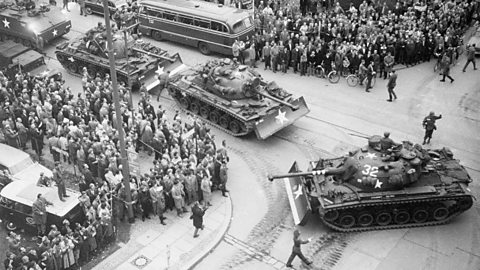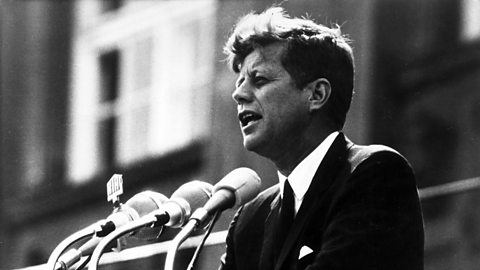The USA's response to the Berlin Wall
Alarmed by the building of the Berlin Wall, President Kennedy sent his Vice-President, Lyndon Baines Johnson, and US General, Lucius D Clay to Berlin.
Stand-off at Checkpoint Charlie

Once the Wall had been constructed, the US decided to test how far they could push the USSR. Foreigners were still allowed to cross the Wall, and the US regularly sent troops and diplomats into the Soviet sector through Checkpoint CharlieThe main crossing point in the Berlin Wall between the East and West Berlin. There was a standoff between American and Soviet tanks here when the wall was first built in 1961., one of the guarded crossing points between East and West. Both sides were entitled to do this under the Four Powers Agreement made after the Yalta Conference, but by constructing the Wall the Soviets were breaking this Agreement and there was a tension over whether or not East German guards were authorised to examine the travel documents of Americans passing through the checkpoint. On 27 October 1961 the US stationed tanks on its side of Checkpoint Charlie.

Fearing the US tanks might try to break down the Wall or pass into its sector, the Soviets responded with an equal show of force and Red ArmyArmy of the USSR. tanks pulled up to their side of Checkpoint Charlie. All day long the two sides, with tanks and soldiers at the ready, faced each other in a tense stand-off. The nail-biting crisis lasted for 18 hours until diplomatic negotiations agreed that both sides would slowly withdraw.
On 26 June 1963, President Kennedy visited Berlin and made a famous speech in which he stated that Berlin was a symbol of freedom and the struggle against communismA classless society where all property is owned publicly.. It was a strong, defiant message and put an end to Soviet hopes that the Western Allies would leave Berlin.
The Berlin Wall remained a symbol of Cold War tension until it was torn down in November 1989.
"Ich bin ein Berliner" speech
Revision tip
The speech President Kennedy gave in Berlin is often called the тIch bin ein Berlinerт speech. In it he showed solidarity (togetherness) with the people of Berlin by saying he too was 'a Berliner'. Those who tried to defect could now end up being shot and many families were divided by the wall.
Kennedy showed that, although he was unhappy with the construction of the Wall, there was nothing he felt able to do about it when he said: Itтs not a very nice solution, but a wall is a hell of a lot better than a war.
What does this quote tell you about Kennedyтs attitude to the USSR after the Berlin Wall had been erected?
There are some who say, in Europe and elsewhere, we can work with the communists. Let them come to Berlin.